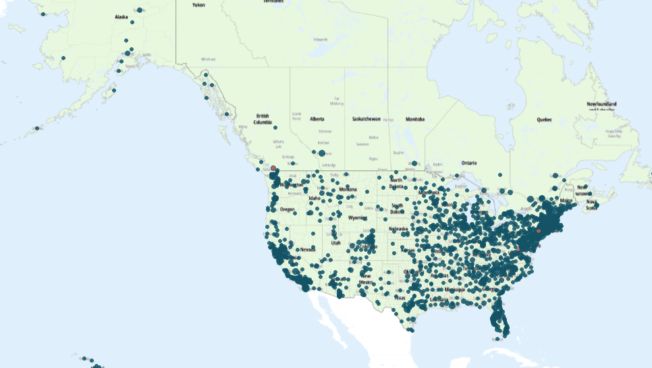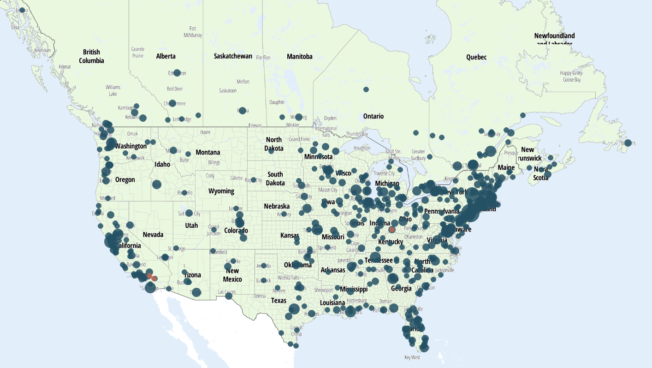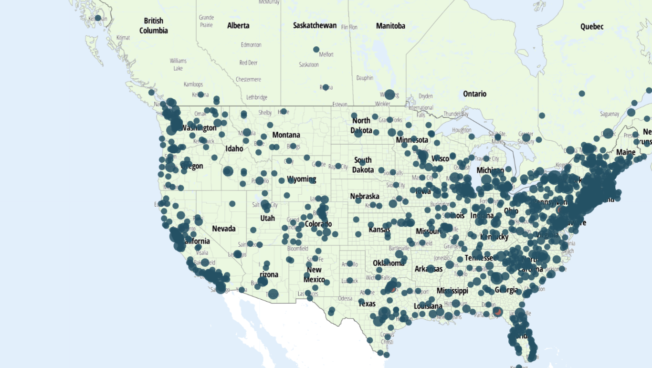Regional Overview
United States & Canada
January 2025
Posted: 14 January 2025
In this Regional Overview covering December 2024
Demonstration trends
This section provides key figures on demonstration events, which includes incidents categorized as 'Protests,' and 'Violent demonstrations' as recorded by ACLED. For more information on event and sub-event types, see the ACLED Codebook
United States
508 demonstration events
19% decrease
compared to last month
Canada
123 demonstration events
47% decrease
compared to last month
United States and Canada: Pro-Palestine events dominate demonstration activity in 2024
Last year in the United States, demonstration events decreased by about 10% compared to the previous year, amid an ongoing decline in demonstrations following years of mass mobilization in major movements in support of Black Lives Matter, access to abortion, labor rights, and other issues. As a result, overall demonstration levels reached their lowest recorded rates since ACLED began collecting data on the US in 2020. Despite this clear overall decline, demonstration events rose in 17 states — which share few common political or demographic features — compared to 2023. In each of these states, over a quarter of all demonstration activity was motivated by pro-Palestine or anti-Israel sentiment. More broadly, demonstrations with a pro-Palestine or anti-Israel element constituted 28% of all demonstration activity in the US and Canada during 2024. This was driven largely by demonstrations on university campuses, where around 40% of these demonstrations occurred.
Though the political climate throughout the early months of 2024 seemed to suggest that demonstrations would crescendo in the lead-up to the US election, demonstration event counts actually reached their single-month peak in May, coinciding with a spike in pro-Palestine demonstrations. This wave of demonstrations can be mainly attributed to campus demonstrations in support of Palestine, which were organized by groups such as Students for Justice in Palestine, Jewish Voice for Peace, and Students for a Democratic Society. Demonstrators remained peaceful at approximately 98% of 2024’s pro-Palestine demonstrations at university campuses in the US and Canada, roughly equivalent to the average rate of non-violence for all demonstration activity in the two countries for the same period (for more on pro-Palestine student demonstrations in the US, see this ACLED Insight). Despite this, police intervened in more than 11% of pro-Palestine demonstrations in the US and Canada in 2024, strikingly more often than the roughly 1% intervention rate across all other demonstration events. As the new year begins, it seems likely that demonstrations in support of Palestine will continue amid ongoing violence in Palestine and President-elect Donald Trump’s continuous support of Israel.
Radical group trends
This section provides key figures on far-right and white nationalist groups.
Far-right groups:
ACLED uses this term to refer to a variety of actors, from 'traditional' militias to militant street movements. Though they are also analyzed separately, this figure also accounts for white nationalist and neo-Nazi groups.
White nationalists:
ACLED uses this term to refer to groups that openly describe themselves as white nationalist, white supremacist, or neo-Nazi.
30
events, of which 22 involve white nationalist groups
9
radical groups active, of which 5 are white nationalist
Radical groups were most active in Arizona
White nationalist groups were most active in North Carolina
Spotlight: A comeback on the horizon for extremist groups?
Extremist group activity peaked twice this year as a result of specific mobilization efforts against immigration and the LGBTQ+ community, though overall extremist activity declined significantly compared to 2023. The first took place in February, during which white nationalist groups such as the White Knights, White Lives Matter, Patriot Front, and the Rise Above Movement participated in a multi-day “Take Back the Border” convoy through border states to express opposition to immigration. Around 40% of all anti-immigration demonstrations in the US in 2024 involved extremist groups — nearly double their share in anti-immigration activity in 2023 — coinciding with virulent anti-immigrant rhetoric during the presidential campaign.1Ted Hesson, ‘Trump aims to deport all immigrants in the US illegally,’ Reuters, 9 December 2024 The second spike in extremist activity took place during June 2024, which is Pride Month in the US. Anti-LGBTQ+ demonstrations were organized against Pride Month events across the country, although at a significantly lower rate than the year before.
The overall fall in extremist activity in 2024 took many observers by surprise, particularly as it did not spike around the November presidential election, nor in response to the assassination attempts against Trump, nor to his conviction on felony charges (for a deeper explanation of these trends, see our September analysis). It is unclear if this trend of low extremist activity in response to Trump-related developments will continue during the president-elect’s second term. After learning that he would be returning to the White House, Trump pledged to pardon participants in the 2021 Capitol Riot, many of whom held leadership positions in extremist groups.2Michael Sainato, ‘Donald Trump promises to pardon January 6 rioters on “day one,”’ The Guardian, 8 December 2024 The arrest of these leaders was a key driver in declining levels of extremist activity in recent years, as groups lost organizational expertise and feared elevated law enforcement scrutiny. The release of these leaders could revitalize extremist mobilization.3Hannah Allam, ‘Trump could hobble renewed fight against domestic terrorism, analysts warn,’ The Washington Post, 6 December 2024
See More
See the Codebook and the User Guide for an overview of ACLED’s core methodology. For additional documentation, check the Knowledge Base. Region-specific methodology briefs can be accessed below.
Links:
For additional resources and in-depth coverage of demonstration and political violence trends across the US, check our dedicated US Crisis Monitor.







